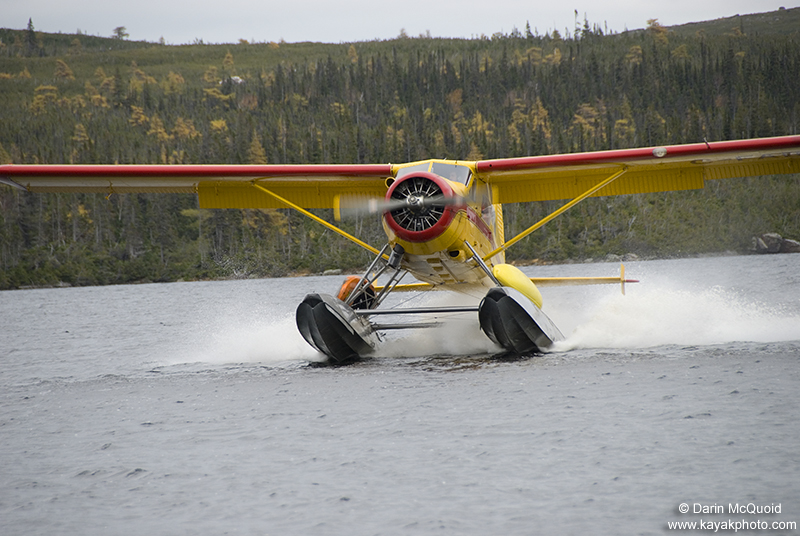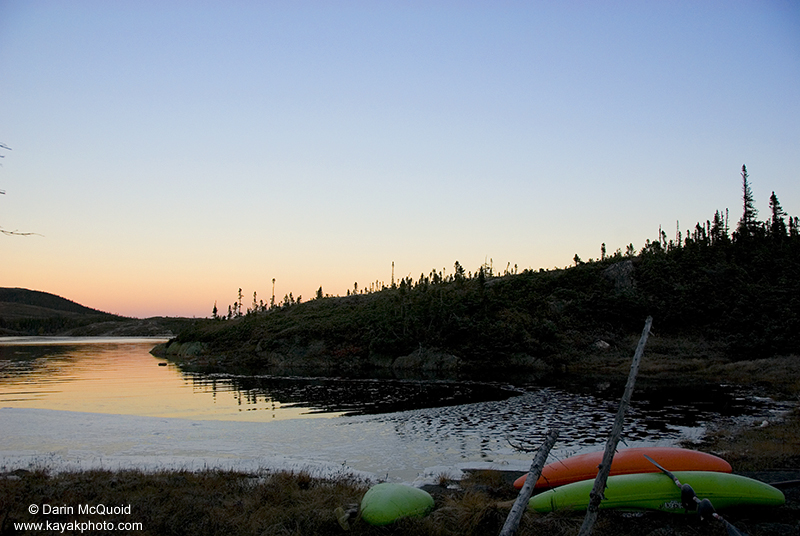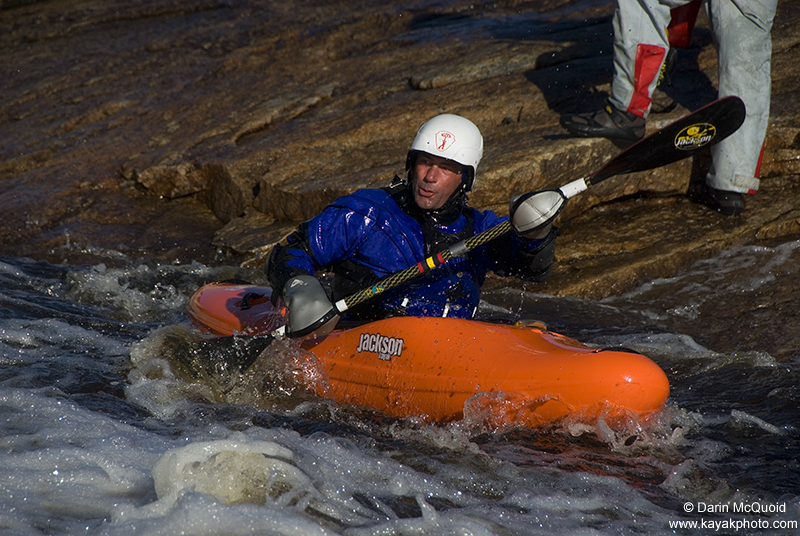
| Darin McQuoid | Blog | Reviews | Tutorials | River Directory |
The
Cloud River
IV-V

IV-V

Back when the seed of Newfoundland had been planted in our minds there was one destination that had to be done. This was the Cloud River. Our beta via Chris Buchanan would cause any class V kayaker to salivate: “First run by Andy Bridge and John Weld. Both guys assure me that this is a full on classic piece of whitewater. Apparently it is a series of waterfalls in a tight canyon, most of which they think are runnable in modern creek boats. On their first descent they were in 12’ fiberglass expedition boats and walked many of the falls due to the fragility of the boats. They also claim that there is a 40’ to 60’ waterfall at the start of the canyon that might, or might not, go. This could be shuttled by float plane or there are fishing lodges that have Argo access to the ponds at the start of the canyon section.”
Leg Pond Feeder had handed out some punishment, but we weren’t going to forgo our scheduled float plane. Driving late into the night we crashed in “downtown” Roddickton, anticipating a full adventure in the next two days.
Filled with expectation we started the day early, organizing our food and sorting gear for a planned two to three day wilderness epic. Out at our pickup location one thing was obvious. It was cold. High humidity and constant wind make the northern peninsula of Newfoundland exceptionally cold. Doing our best to ignore the chilly breeze blowing across the pond we quickly packed gear into our boats and suited up. Nervous with expectation we were worried when our plane wasn’t on time, but soon enough the sound of the engine relieved our stress.

I knew nothing about aircraft, but in kayaking circles I had heard the name Beaver passed around when planes were mentioned. Legendary in aviation circles, the de Havilland DHC-2 Beaver
would be our transportation into the headwaters of the Cloud River. Our particular plane was from 1958 and looked absolutely beautiful.

Using a World War II surplus engine, just the sound of a Beaver had me super pumped up to be in the air. You really just have to hear it in person, it’s what a plane should sound like. Seating four, it would take two trips to get into the headwaters.
Flight
#1, it feels like a million
miles from civilization. Lots of
moose, elk and caribou though.


We unloaded quickly and searched for dry wood to make a temporary fire, it was cold and we had at least an hour before the rest of the group arrived. Damp wood made this task hard, but eventually we got a fire going and enjoyed the heat.
The
second flight arrives to the
headwaters.


We
quickly unloaded the second group
and said goodbye to Bill, our
stellar pilot. I’ve heard that a plane leaving is one of the
loneliest moments in wilderness travel.


It
really didn’t feel that
lonely with our solid team of
paddlers. We felt more anticipation than trepidation.


Throwing in the gear and getting on the water was our focus for the next fifteen minutes, and soon enough we were paddling across the first of what proved to be many lakes. These were split up by braided out class II-III rapids, and more ponds. As the afternoon progressed the rapids slowly gained water, although the ponds never let up. One large bedrock slide that would have been amazing with more water led into a larger pond. Swearing it must have been the first of the two “Twin Lakes” we had originally planned on flying into, we paddled across the pond with late afternoon setting in. To our surprise we ran into a boat of locals, who informed us that we had just reached the first lake of Twin Lakes. They also mentioned that we would find the rapids below the lakes to be “quite exciting” and that it would get very cold during the night.
The flat water slog continued, my recently healed shoulder starting to give me pain from all the paddling. As the group pushed ahead across the three miles of the second Twin Lake, I was rewarded with seeing a Caribou swimming across the lake right in front of me. It was quite a sight to behold. Reaching the outlet of the lakes we were rewarded with a beautiful class IV rapid and no shortage of water. Several ledges followed, one needing a quick scout and revealing a popular sneak on the left, or down the right over a rooster into a nice big hole.
The
rooster tail ledge as
evening sets in.


Below
the ledge were the largest
bubbles I have ever seen in a river,
these are at least 6” in diameter.


One thing was clear at this point. It was going to be a cold night, with the sun dropping and a brisk breeze picking up we were already cold. Multi-day kayak expeditions in Newfoundland aren’t easy. When there is flat ground it’s almost always marsh or the infamous tuckamore, dense tundra trees.
In the evening light we could see the river disappear into a large gorge downstream, and knew that we had to take advantage of whatever camping opportunity was available. Spreading out on both sides of the river we weighed our options, and found a spot on the left that had some patches of dry ground and plenty of firewood. Daylight was fading fast, so we focused on gathering massive amounts of firewood that we knew would be needed to warm us. Five minutes into gathering wood Nick went back to get something from his gear, and found that it was frozen already.
With our tents setup and a large fire blazing we settled into the routine of making dinner and enjoying the warmth of the fire. As temps dropped it was obvious that this was country where a drysuit was a necessary tool for survival on overnights. As our water bottles froze and snow started falling, all attempts were dropped at claiming this wasn’t our coldest overnight in a kayak. The snow sent us to bed, the majority of us dreaming of a warm nights sleep in our worn out 20 degree bags. Sometimes dreams stay just dreams.

Waking up early I was glad there was still some dry fire starter left over from the night before, and got the fire going to start drying camping gear and defrosting our paddling gear. We rolled out of bed in relation to how warm we slept, and soon enough everyone was up. Normally we can get on the river pretty quickly, but thawing all the frozen paddling gear made packing up take a bit longer.
Blue skies and warmth shined down upon us as dawn turned into day. Paddling off from shore, half our group blessed their fortune in remembering to bring pogies, and the other half lusted after this rarely used piece of gear. Right after camp we were greeted with a nice early morning ledge.
Good
morning Jesse Coombs!

In typical style the river flowed through another long
pool, and then
dropped over a big horizon line. The rapid was a classic mixture of
class V, simple and complex at the same time. Big boof, big slide, big
hole. With lots of cross currents, folds, boils and highly aerated
water. 
With myself suffering a sore shoulder, and Nick suffering a sore back from Leg Pond Feeder, we quickly portaged down a granite slab on the right while everyone got setup. EJ opted to run it first, came off the top with lots of speed, got a good boof but was rear endered by the first hole, rolling up as he accelerated down the slide backwards.

Hitting the hole sideways he started getting the classic big hole ride, bouncing all over the place but keeping upright and trying to work his way out.
EJ
worked his way to the corner, but
she wasn’t done with him
yet and pulled him back into the center.


Taking
one more cycle through the meat
of the hole, EJ worked back out
the right, whew what a ride!


To give you an idea of the ride, I took twenty-three pictures while EJ was in the hole, and I wasn’t sequencing. Relived by EJ’s ability to ride it out, the rest of the group proceeded to fire off the slide we dubbed “The Bearded Lady”. Joel came through with the most monumental tail stand I have ever seen.
Still
holding

Truly a tail stand of epic proportions, Joel starts to bring her home.


Truly a tail stand of epic proportions, Joel starts to bring her home.

The
buzzer has rung and Joel tames the
beast.


Downstream
it was apparent that our
gorge was directly below us, and
knowing we had a long day ahead we pushed through several more ledge
drops into the heart of the gorge.


After the open setting of the headwaters, the gorge looked like it would deliver everything it was promised to. The entrance rapid lived up to our fears and expectations. Dropping nearly sixty feet total, the convoluted waterfall had everyone thinking twice after just taking a glance at it. This photo does no justice to the waterfall, but does show the gorge it locks the paddler into.

Flowing through a large entrance ledge, the river dropped onto a large slab sloped to the right, forcing most of the water into the right wall and over a forty foot free fall. Splitting up, Ben scouted down the left, Jesse and Joel on the right, and EJ, Dane, Nick and myself started a portage on the right. The scout of the entire gorge took several hours, and during this time Nick and I found a way to access the gorge after only portaging the two marginal initial drops on the right. We waited for the rest of the group to come down, and between the bad lighting and time spent portaging I neglected all shots of the first two drops. Ben, Joel, Jesse and Chris all ran the first waterfall and slide, meeting Nick and I for the rest of the gorge.
This
is the second slide in the gorge,
the lighting was as bad as it
gets, this is with a polarizer on to cut down glare, but no dice.


Knowing we could work around almost everything at river level, Nick and I met up with the boys above a perfect twenty footer, where I missed the shot while chasing Joel’s paddle downstream. Below the clean falls was a large chunky rapid that we ran the entrance to and seal launched from the left side, while Jesse opted to run the whole thing, and had no problems.
Several large rapids still existed before we could get out of the gorge, one ledge with a horrible pocket on the right, and three rapids and a ledge. Chris Korbulic runs one of the rapids, which looks small in this photo, until you see the next one where he has completely disappeared in the hole.

Chris,
Chris, where did you go?


We really had the perfect flow in the gorge, enough to cover the mank, but it still gave us eddies above drops in the bottom of the gorge where it would get scary at high flows. Chris Korbulic approaching the horizon line that’s spewing smoke, note the pool in the light below the gorge, the black figures standing next to it are Dane and EJ.

The
smoking horizon was a nice fifteen
foot slide to vertical drop that
Jesse Coombs enjoys.


Just
one more drop to exit the gorge.
One big boulder garden filled
with mank, where the line was to boof hard or piton.
Chris Korbulic approaches the final rapid in the Cloud Gorge.

Chris Korbulic approaches the final rapid in the Cloud Gorge.

Exiting the gorge and reunited with our whole group, we were happy to have completed the gorge, but wasted no time rejoicing because we only had two hours to finish paddling out, including a eight kilometer paddle across the inlet and bay to Roddickton. Several high quality rapids below the gorge surprised us, including one double hole drop that caused our only swim on the Cloud.
We hit the inlet without too much daylight left, and to our despair the tide was coming in, meaning we would be paddling against swift current for the next six kilometers. Knowing we only had to make it past the point to where we could see light, we pushed hard and eventually made it to Roddickton right at night fall, and right as temperatures dropped to well below freezing






